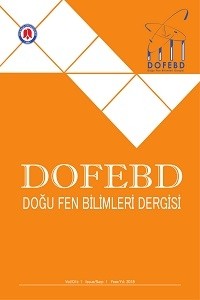Bazı Bitkilerin Alkol Ekstrelerinin Antimikrobiyal Özelliklerinin Belirlenmesi
Bu çalışmada kocayemiş (Arbutus unedo), kızılsöğüt (Alnus glutinosa), ayı üzümü (Vaccinium myrtillus), at kuyruğu (Equisetum arvense), livor (Sambucus nigra) ve ökse otu(Viscum albüm) bitkilerinin alkol özütleri elde edilmiş ve 5, 10, 20, 40, 60 μl konsantrasyonlarda Escherichia coli, Bacillus cerreus, Klebsiella oxycota,, Arthobacter agilis bakterileri ve Candida albicans mayası üzerindeki antimikrobiyal etkileri belirlenmiştir. En iyi antimikrobiyal aktiviteye sahip olan bitki özütünün kızılsöğüt bitkisine ait olduğu ve herhangi bir etki göstermeyen bitki özütünün ise ayı üzümü olduğu tespit edilmiştir.
Anahtar Kelimeler:
Bitki alkol özütü, antimikrobiyal, , antifungal
___
- Abreu, O. A., Sánchez, I., Barreto, G., & Campal, A. C. (2017). Poor antimicrobial activity on seven cuban plants. Journal of Pharmaceutical Negative Results, 8(1), 11.Al-Snafi, A. E. (2016). Medicinal plants with antimicrobial activities (part 2): Plant based review. Sch Acad J Pharm, 5(6), 208-239.
- Basri, D. F., & Fan, S. H. (2005). The potential of aqueous and acetone extracts of galls of Quercus infectoria as antibacterial agents. Indian journal of Pharmacology, 37(1), 26.
- Bauer, A. W., Kirby, W. M. M., Sherris, J. C., & Turck, M. (1966). Antibiotic susceptibility testing by a standardized single disk method. American journal of clinical pathology, 45(4_ts), 493-496.
- Bessa Pereira, C., Gomes, P. S., Costa‐Rodrigues, J., Almeida Palmas, R., Vieira, L., Ferraz, M. P., ... & Fernandes, M. H. (2012). Equisetum arvense hydromethanolic extracts in bone tissue regeneration: in vitro osteoblastic modulation and antibacterial activity. Cell proliferation, 45(4), 386-396.
- Dahija, S., Čakar, J., Vidic, D., Maksimović, M., & Parić, A. (2014). Total phenolic and flavonoid contents, antioxidant and antimicrobial activities of Alnus glutinosa (L.) Gaertn., Alnus incana (L.) Moench and Alnus viridis (Chaix) DC. extracts. Natural product research, 28(24), 2317-2320.
- De Martino, L., De Feo, V., Fratianni, F., & Nazzaro, F. (2009). Chemistry, antioxidant, antibacterial and antifungal activities of volatile oils and their components. Natural product communications, 4(12), 1934578X0900401226.
- Dib, M. E. A., Allali, H., Bendiabdellah, A., Meliani, N., & Tabti, B. (2013). Antimicrobial activity and phytochemical screening of Arbutus unedo L. Journal of Saudi Chemical Society, 17(4), 381-385.
- Gomathi, D., Kalaiselvi, M., Ravikumar, G., Devaki, K., & Uma, C. (2015). GC-MS analysis of bioactive compounds from the whole plant ethanolic extract of Evolvulus alsinoides (L.) L. Journal of food science and technology, 52(2), 1212-1217.
- Hussain, M. A., Khan, M. Q., Hussain, N., & Habib, T. (2011). Antibacterial and antifungal potential of leaves and twigs of Viscum album L. Journal of Medicinal Plants Research, 5(23), 5545-5549.
- Konyalιoğlu, S., Sağlam, H., & Kιvçak, B. (2005). α-tocopherol, flavonoid, and phenol contents and antioxidant activity of Ficus carica. leaves. Pharmaceutical biology, 43(8), 683-686.
- Moussaoui, F., & Alaoui, T. (2016). Evaluation of antibacterial activity and synergistic effect between antibiotic and the essential oils of some medicinal plants. Asian Pacific Journal of Tropical Biomedicine, 6(1), 32-37.
- Oliveira, B. D. Á., Rodrigues, A. C., Cardoso, B. M. I., Ramos, A. L. C. C., Bertoldi, M. C., Taylor, J. G., ... & Pinto, U. M. (2016). Antioxidant, antimicrobial and anti-quorum sensing activities of Rubus rosaefolius phenolic extract. Industrial Crops and Products, 84, 59-66.
- Semeniuc, C. A., Pop, C. R., & Rotar, A. M. (2017). Antibacterial activity and interactions of plant essential oil combinations against Gram-positive and Gram-negative bacteria. journal of food and drug analysis, 25(2), 403-408.
- Sepahvand, R., Delfan, B., Ghanbarzadeh, S., Rashidipour, M., Veiskarami, G. H., & Ghasemian-Yadegari, J. (2014). Chemical composition, antioxidant activity and antibacterial effect of essential oil of the aerial parts of Salvia sclareoides. Asian Pacific journal of tropical medicine, 7, S491-S496.
- Sharifi‐Rad, J., Salehi, B., Varoni, E. M., Sharopov, F., Yousaf, Z., Ayatollahi, S. A., ... & Iriti, M. (2017). Plants of the Melaleuca genus as antimicrobial agents: From farm to pharmacy. Phytotherapy Research, 31(10), 1475-1494.
- Swamy, M. K., Akhtar, M. S., & Sinniah, U. R. (2016). Antimicrobial properties of plant essential oils against human pathogens and their mode of action: an updated review. Evidence-Based Complementary and Alternative Medicine, 2016.
- ISSN: 2667-6958
- Yayın Aralığı: Yılda 2 Sayı
- Başlangıç: 2018
- Yayıncı: Hakkari Üniversitesi
Sayıdaki Diğer Makaleler
Bazı Bitkilerin Alkol Ekstrelerinin Antimikrobiyal Özelliklerinin Belirlenmesi
Özlem Gülmez, Ömer Faruk ALGUR
Mikrodalga Enerjisinin Buğdayda Çimlenme, Erken Fide Büyümesi ve Mitotik Bölünme Üzerine Etkisi
Ayten EROĞLU, Nlüfer ÇİRİĞ SELÇUK
